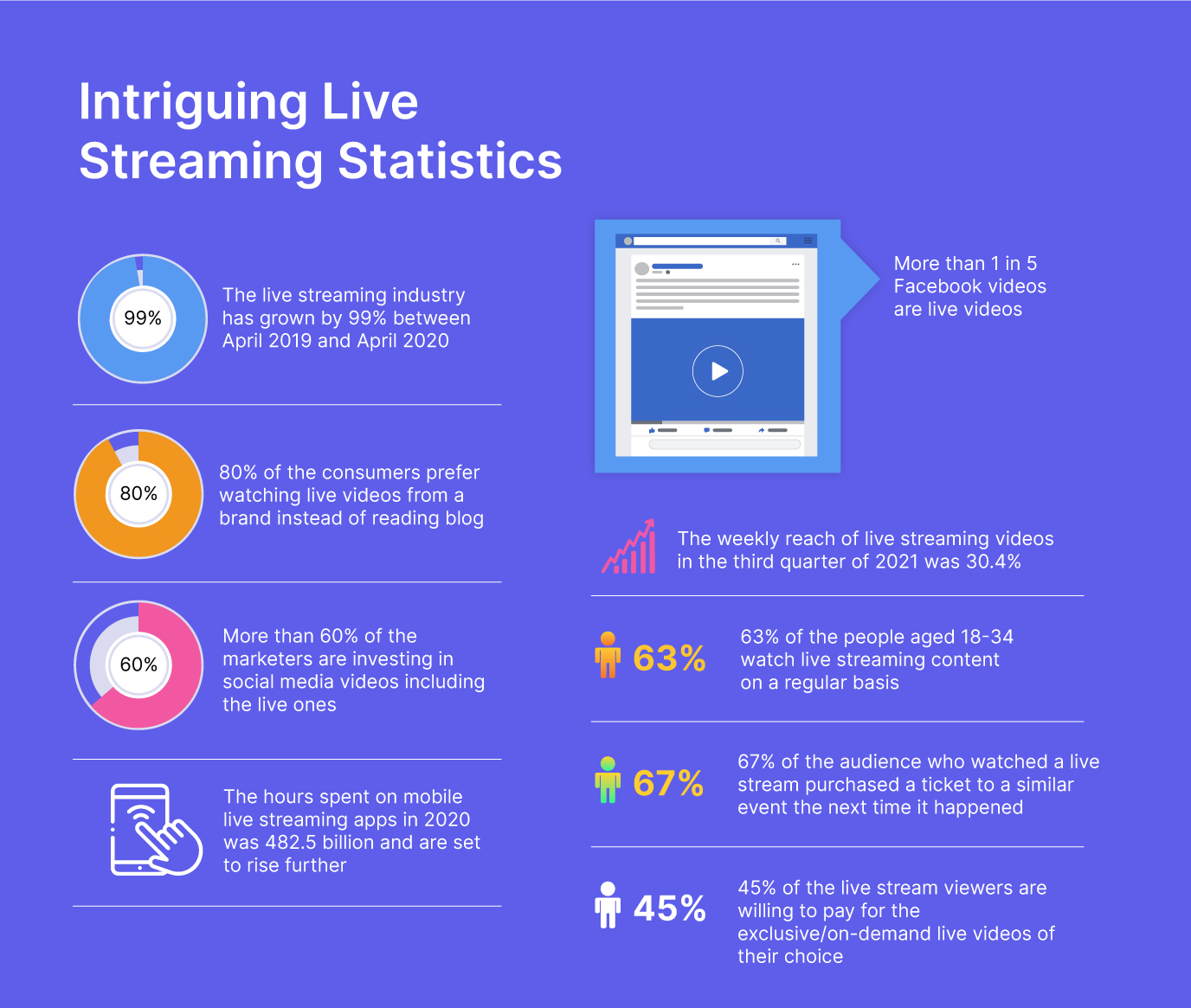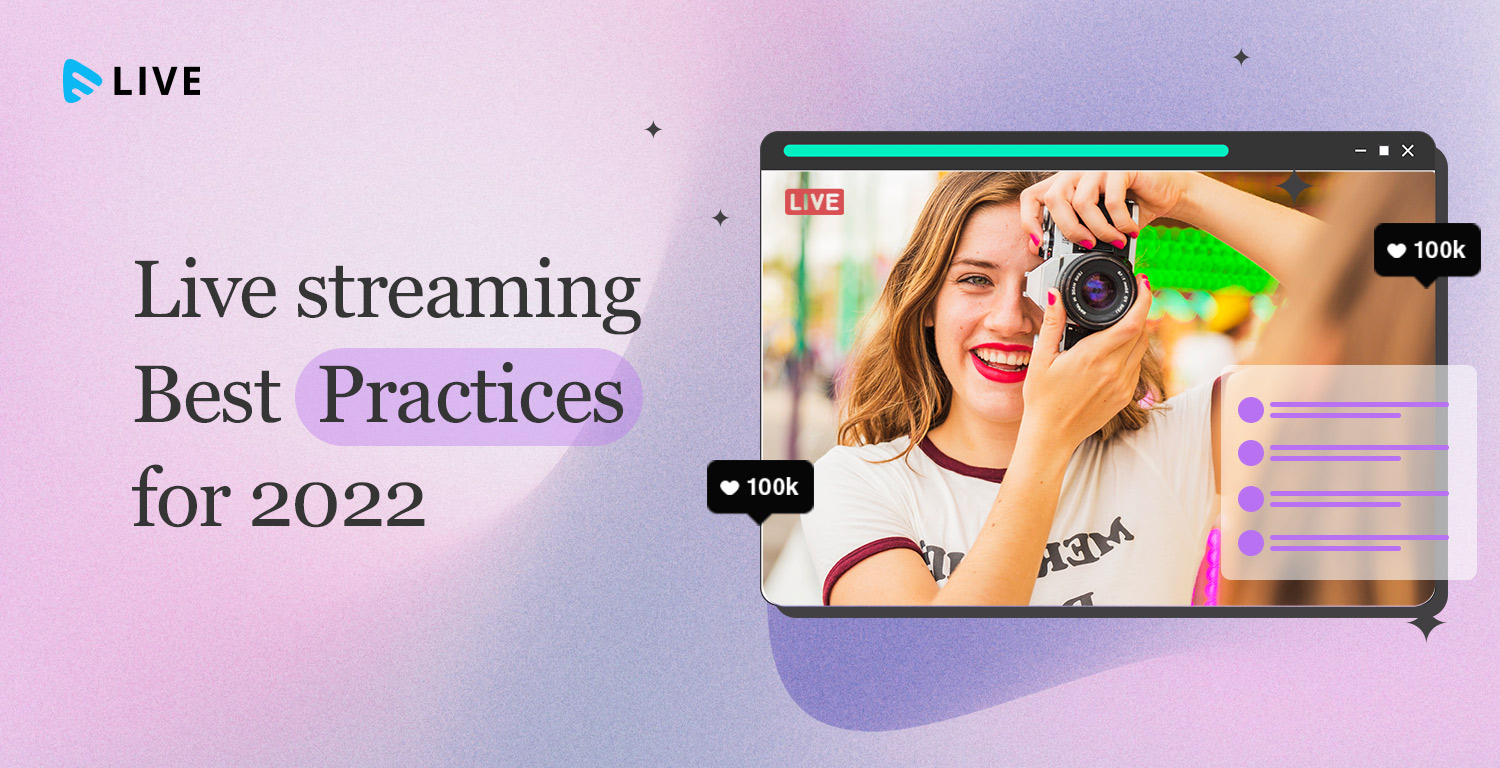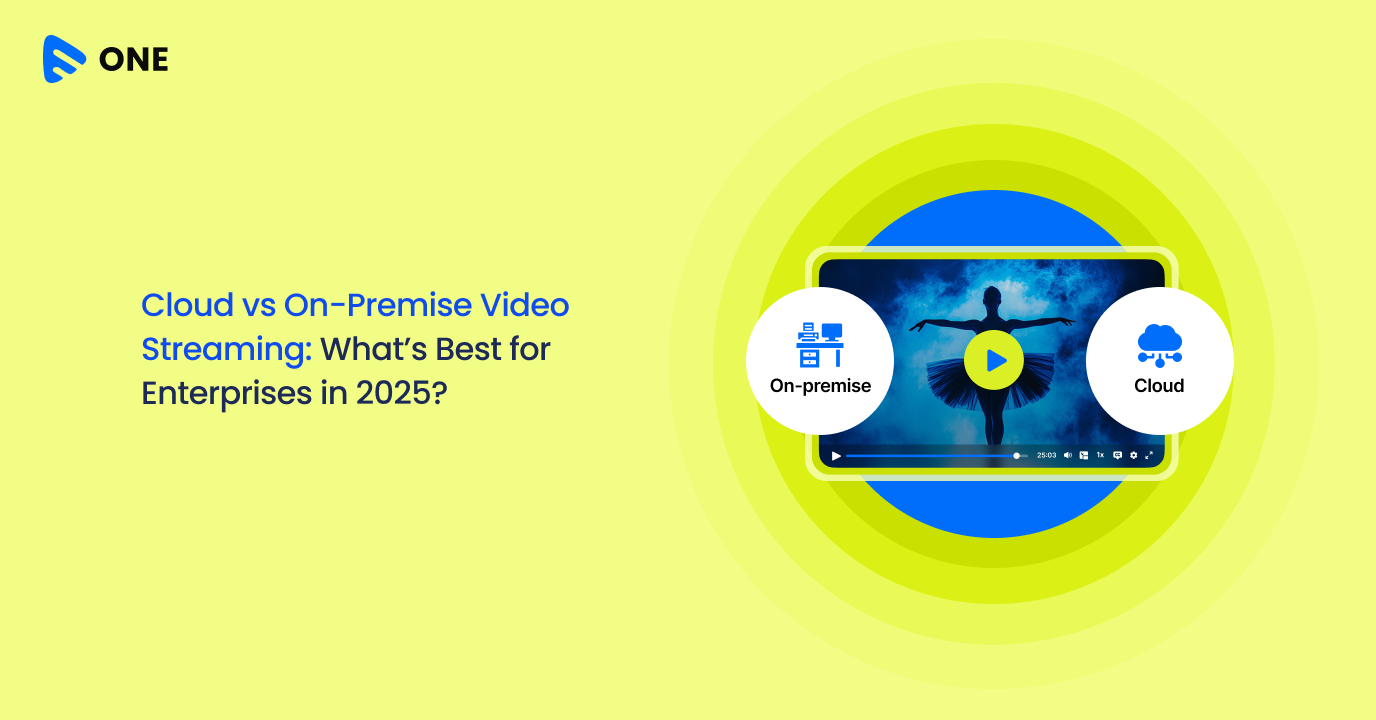The global live streaming industry is expanding and evolving fast, taking the ‘new normal’ for various industries, sectors, enterprises, content creators, and even artists/individuals from various backgrounds to the next level. Not only has the adoption of live streaming spiked exponentially over the last few years, but also the outbreak of the pandemic has given it the much needed push to thrive whilst creating its permanent place.
No wonder that the global live streaming industry is set to surpass US $223 billion by 2028, as stated in a latest report by ResearchAndMarkets. To give an estimate, 42% of the U.S. population live streamed online content in 2018, a sharp rise from 25% in 2017, that is much before the pandemic started normalizing virtual events, e-meetings, and more. The trend is going to last, but being a dynamic sector, the practices may keep changing based on certain factors. To take you through a more detailed overview and insight, we will discuss the live streaming best practices for 2022. Let’s see what’s in store!
What is Live Streaming and Why is it Trending?
Live streaming refers to streaming video/audio content over the internet to an audience in real-time. Live streaming isn’t pre-recorded, at the base of its concept. The live streaming sector holds a major portion of both audio and video streaming market owing to its unlimited perks over VOD or AOD content/on-demand streaming such as-
- It’s fast and much more efficient in terms of production and delivery
- Interactive live streaming lets your audience watch and engage with your content in real-time as well as share their views, opinions, comments etc.
- Live streaming has become a common feature even in the leading social media platforms including Facebook, Instagram, YouTube etc. As a result, live streams help you target these audiences
- Live streaming is suitable for various occasions, events, and purposes and helps you meet certain goals easily.
- Live streaming is highly popular among artists & influencers to let them connect and bond with their audience/fans.
- It is highly effective in repurposing content of various formats, such as written, videos, on-demand content and others. For instance, you can convert an e-guide into informative and interactive live streaming where you can guide the audience on that particular topic in a more interactive way, you can convert the product/feature roadmaps/guides into Q/A live stream and so on.
Furthermore, live streaming itself can be used as an effective strategy to follow in marketing, to improve the important metrics like customer retention rate, ROI, brand promotion, and many more. To know more about the power of live streaming, read our blog – Why is Live Streaming a Must-have for Marketing?
Next, we will go through some of the live streaming statistics that represent its rapidly increasing adoption, usage, and potential.

Best Practices for Live Streaming in 2022 – A Guide to Follow
1. Keep a Complete Plan Ready
A detailed plan can help you make your live streaming more purposeful, efficient, and successful. The live streaming sector is getting stricter day by day in terms of competition, and so without a plan it will be tough to move forward. Outline and prepare your whole live streaming plan.

A few points to take care of –
- The Purpose of Live Streaming – For instance, the purpose of live streaming product launch is to introduce the product in the market and to the audience, while the purpose of live streaming Q/A is to educate your customers on the products/services or relevant topics and so on.
- The Goal of Live Streaming – Any type of live streaming can help you reach some common goals in terms of content frequency, audience reach, engagement, and others. But, to optimize the efficiency of your live stream videos further, you need to decide the parameters/metrics you want to improve or certain goals you aim to achieve. For example, if you are doing a brand story video then your goal should be more focused on improving the brand image, brand impression and conveying the said brand values to your audience. But for a product demo stream, the focus should be different such as promoting the exclusive product features/solutions etc. This step is important because based on this you will be able to plan other things such as CTAs, platforms, etc. that we are going to discuss later in this blog.
- Know Your Audience – This sounds like a no-brainer, but it actually requires a lot of research. From which sectors your audience are from, what demographics they belong to, how diverse the industries/sectors are that you want to target, whether your audience belongs to different demographics or not – a clear knowledge on all these help you keep the foundation as well as the live stream planning in the right way.
- Market Research – A thorough market research on the domain you are operating in, not only completes the process of a fool-proof live streaming plan, but also saves you from any possible hurdles you may come across in the future. An insightful market research helps you in coming up with the competitive and relevant live streams along with proper market positioning.
2. Use the Best Live Streaming Solution
An enterprise-grade, robust and secure live streaming solution should be your basic need to live stream in 2022. The best practice will be to not compromise with features/solutions and always looking for more from a live stream service provider.

There are plenty of live streaming solution providers in the market, and the best you can do is go for the one that will help you make your live stream more competitive. How? You need to ensure that the live streaming service/solution provider offers an all-in-one solution that includes the following must-have solutions/features –
- It offers easy launching of your live streaming platform along with your own branding which is very important to create a strong brand impression through every live stream. Even if you are an individual artist or professional, a unique branding makes your live streams more recognizable. As per the statistics, it takes 5 to 7 brand interactions before a customer remembers a brand, and live streaming is not an exception, a consistent live streaming plan should also convey your brand values to create a long-lasting impact among your audience.
- Lets you convert/enhance a third party live feed into a secure buffer-free live feed with built-in CDN and DRM protection. In case you want to enhance the basic HLS or RTSP third party feed into a professional live stream, this feature will allow you to do it easily.
- Can easily record third party live streams and store them as on-demand content.
- Offers an extensive content library along with easy solutions for multi-format uploading, auto-transcoding, subtitling, animated thumbnails, filter/sort/search and others.

- Simple user on-boarding solution that includes social media authenticator, email verification, and free content log in.
- In-built encoding and transcoding solution that supports multiple file formats such as MP4, VOB, AVI, MPG, and MKV, to name a few.
- Comes with the solution of auto bitrate management and multi bitrate transcoding that synchronizes as per the user network bandwidth without buffering.
- Supports audio encoding for multiple formats like acc, wav, m4b. M4p, raw, and others to convert them into .MP3
- Another factor, which you must not overlook is- easy launching. Opting for a third party live streaming platform provider implies that you don’t want to go through the hassle of many technicalities that are needed to build a live streaming platform or wait for a long time. But there are many live streaming platforms that need significant technical knowledge from your side, have a steeper learning curve, and long turn-around time. However, only opt for one that lets you launch your live streaming platform quickly without any technical knowledge.
- Offers HLS (HTTPs Live Streaming) solution as HLS being a mobile-friendly format is high on-trend now.
- There are Multiple monetization models and options so that you can pick up any one that suits the live stream content, purpose and optimizes the earning. Pay per view, ads insertion, donation- these are some of the best ways to earn from your live streaming.
- It has a global payment set-up which means any customer from any end of the world can do easy transactions through multiple currencies and multiple payment gateways and can get multi-language support.
- It comes with viewer-friendly live stream solutions such as- streaming from the nearest server to provide seamless live streaming experience for the audience around the globe, viewer engagement tools so that they can rate, comment, like your content and make it more interactive etc.
- Another important factor to consider is – marketing/promotion. Marketing live streams is not only a trend in 2022, but also an all-time necessity that helps you reach out to a large pool of audience. Easy social media integration, live stream recording and easy sharing across multiple devices/platforms, simultaneous live streaming on different media – these all help you in promoting your live streams. In a recent survey, 25% of the marketers claimed that live videos are the most effective social content. Moreover, people share live video content twice as much as any other content. No wonder that brands and marketers are getting inclined towards live streaming more than ever in 2022 and it’s a trend that is going to last even in the coming years.
- Security, analytics, & insights are other significant factors to consider. With the growing popularity of live streaming the increased risks of security threats also comes into the play. The best practice will be – securing your live streaming content in every way possible, like, multi-DRM protection against piracy, watermarking, Geo-blocking etc. On the other hand, analytics and insights help you in tracking the stream health, performance, and audience engagement metrics so that you can optimize them all and position your live content better in the competitive market in 2022.
3. Optimize Your Live Streaming Set Up
For quality live streaming, you need proper live streaming equipment. A live streaming camera, microphone/microphones, Internet connection, and an encoder- these are the basic tools.

But here’s more to optimize them for the best output possible. Let’s summarize it for your convenience –
A Good Video Source for High Quality Live Streaming
Webcams
Webcam can be your go-to solution to live stream without spending anything extra as it comes in-built with laptops. You can also connect it with computers that won’t require much spending. Most of the webcams offer 1080p quality. However, for more professional outputs, you will need a better camera with higher video quality and more features.
DSLR Cameras
They help you deliver high quality video content along with additional advantages such as – better capture in low light, more control to auto focus and manual settings, and others.
Action Cameras
Action cameras are good to capture immersive action-based live streaming – be it sports, gaming, or others. These small, handy digital cameras are also highly preferred by the live streamers owing to their capability to capture high resolution immersive shots/live videos, flexibility to use in any way like, can be mounted anywhere easily and others.
Camcorders
Crystal-clear HDMI outputs to professional video streaming – camcorders are first choice for many to create brand-defining, high-quality live streams.
Video Encoder
Unless you are using a webcam, a video encoder is required to convert your live videos to a ready-to-stream video format. Some basics of the encoder settings is given below –
- Output resolution (Size of the output video frame) – 1080p or 1920 x 1080 for Full HD
- Video Bitrate ( The quantity of video data uploading per second) – 1000-8000 kbps
- Frame rate (The frequency at which the frames in the livestream are displayed) – 30-60 fps is ideal
The video encoder settings can vary based on the platform/media such as – Youtube Live Streaming Encoder Settings, Facebook Live Streaming Encoder Settings, and others.
A Good Audio Source
You can choose from different types of microphones that fit the live streaming audio requirements the best. Built-in microphones to XLR (External Line Return that are more versatile microphones and work well even in non-digital set ups) microphones, you can choose according to the live streaming content. For instance, if you are doing a Q/A live stream, then an in-built microphone can also work well. But if you are doing a live music concert or podcast then dynamic microphones, microphones for vocal production, XLR can be your choice. A good practice is to –
Decide the audio type for your live stream content and how important it is → Research on the competitive audio source options → Pick out the one that suits your live stream purpose and budget the best
Other Equipment You Need
It is important to focus on other live stream equipment/set-up such as Tripods, lightings, green screen (if needed) etc. to bring the best in your live stream.
4. Engage More with the Viewers
Engaging live videos are always going to be on trend. Always try to make your live videos interactive by incorporating – Q & A, quizzes, discussion, and others. As stated in a survey by the Interactive Advertising Bureau, nearly 50% of the live streaming video viewers are watching more live videos compared to a year ago, where interactive live videos drive their engagement even further.

One of the most vivid examples is – Amazon’s interactive videos that are taking the e-commerce customers’ experience to the next level through interactive live video content. It is clear that live streaming is getting adopted in a broad range of sectors and one of the constants to make them more effective is make them more interactive.
5. Streamline the Workflow
As discussed above, live streaming contains several equipment, set-up, and processes. Streamlining the related workflow helps in having a clear picture of the upcoming live steam, how to make it even more organized and successful with no last-minute rush –
- Set up all the equipment at the proper places beforehand
- Organize the cables/connectors between the tools/equipment if any

- Set-up the settings for encoder, audio/video mixer
- Complete the whole arrangement including lighting, studio set-up, sitting arrangement, and others
- Run a test for the live stream by broadcasting it privately
- Fix the possible loopholes if any to increase the level of perfection in your final live stream
6. Have Clear and Relevant CTAs
CTAs are what make your live stream even more purposeful. The live streaming sector is highly competitive in 2022 and it is probable that your audience will forget about it as soon as the live stream is over. At the same time, providing CTAs with your live stream will drive them to take instant actions instead of waiting for it later.

For instance, you can keep sign up/free trial button along with your live stream so that the viewers can take instant free trial or subscription that can help you in customer acquisition, or, if it is a live music concert, you can attach the CTA for the special discounted pass for the next concert and so on. As per the statistics, more than half of the viewers purchase from a brand during a live video. So, CTAs are being used at an increasing rate by the live streaming providers to boost the conversion rate further.
7. Promote Your Live Streaming in Advance
The best practice to make your live streaming videos reach the largest audience possible is to promote them beforehand. Not promoting your live streaming implies that half of its potential will remain unexplored.

Furthermore, it’s important to target the audience in different other platforms too including social media. A few tips that always work in promoting your live videos –
- Create events with pre-registrations on Facebook, Instagram, LinkedIn, and other social media
- Promote the live event along with actionable buttons to buy passes/participate on the homepage of your app/website
- Do email marketing along with push notifications
- Provide special offers, discounts, coupons, add-ons etc. to drive more traffic to the live events
To learn more about live streaming promotion and marketing, read our blog Guide to Market Your Live Videos in 2022.
To Conclude
Undoubtedly, live streaming has become widespread from business to creative events. At the same time, people have discovered how it can be used as a tool for marketing, brand presence, and improving the key areas, be it increasing acquisition rate or boosting profit. As a result, the competition in this field is increasing fast. The above-mentioned best practices for live streaming are not only relevant in 2022 but even in the upcoming years as the demand and adoption of live streaming tend to surge further. It is pivotal to choose the right live streaming platform to make your journey easier with it.
Muvi Live, the industry-grade live streaming platform, offers an all-in-one solution for live streaming in diverse sectors – e-learning to OTT. Packed with the top-notch features like ultra low latency live streaming, interactive presentation, and easy social media integration, to name a few, Muvi Live caters to all your live streaming requirements. Want to try it out? Take a 14-day free trial (no credit card needed) now!


























Add your comment